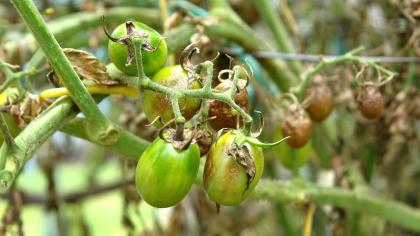What is tomato blight?
Tomato blight is caused by a fungus that makes tomato and potato plants lose their fruit, leaves, and overall health. The fungus spores can germinate within 2 hours to as fast as 30 minutes, depending on the right combination of favorable conditions. Temperatures of 80°F to 85°F coupled with moisture from rain, fog, dew, or irrigation, provide the perfect environmental conditions for early tomato blight. Water splashes the spores in the soil up onto the lower leaves of the plant which then spreads to other parts higher up the stem.
Do my plants have tomato blight?
Tomato blight has a few classic symptoms which help in diagnosing the disease. The most common symptom is the appearance of dark spots or “lesions” on the leaves of the plants (see picture on the right) which typically work their way up from the lower, older leaves to the top of the plant. In addition to the dark lesions, early blight can also cause collar rot, stem cankers, fruit rot, and damping-off. Once you’ve diagnosed that your tomato plants have blight, cut don’t pull infected leaves from the stem. Discard the trimmings by deeply burying, burning them, or placing them in a bag for garbage collection. Never put the infected parts of the plant into your compost pile.
How do plants get tomato blight?
The fungus which causes the blight is called Alternaria solani. Its spores can survive all winter in contaminated soil. The fungus spreads to the soil from previously infected plants, or by water, wind, insects, animals, or people. An infected plant will not recover but you can slow down the spread of the blight by trimming off the infected branches. Take care not to touch healthy plants near the infected one, especially pepper and potato plants.
How to control tomato blight for future gardening?
- Healthy plants with adequate nutrition are less susceptible to disease. Water plants properly, keep the soil healthy, and feed them every 15 days with organic plant food. Before planting add Potash and mix it into your soil. Potash will provide the potassium the tomato plant needs for more fruit vs fertilizers high in nitrogen which promotes more leaf growth at the expense of blooms and fruit production.
- After planting, spread natural mulch at the base of the plant to prevent the spores from splashing onto plants during watering. Also, trim off the lower branches.
- Apply Protilizer® every seven to ten days for effective prevention and control. Drench the plant, bottom near the root area and allow the product to puddle at the stem.
- If your plants happen to contract early tomato blight, harvest any of the unaffected fruit without contaminating healthy ones and remove the plant.
- To remove the plant, place a trash bag over it and pull the entire plant up from the soil. Try to contain as much of the foliage and plant debris in the bag as possible.
- There is a method called soil solarization which would be a good way to control tomato blight and other soilborne fungal and bacterial plant pathogens in soil for future gardens. Steps for the solarization process to follow at the end of this article.
- Once all affected plants are removed, treat the soil with Protilizer® to control any remaining spores. Then, turn the soil under and allow the naturally occurring microbes to remediate the area.
- At the end of every season, clean all tools, supports, etc. with warm water and antibacterial soap or white vinegar.
Here are the steps for soil solarization.
- You will need to do this during a hot time of the year, 4 to 6 weeks.
- Discard all spent plants.
- Till and deeply water the area.
- Cover the area with clear plastic, and hold it down with heavy stones, cinderblocks, or anything that won’t rip the plastic. Plastic needs to be snug against the soil.
- Leave alone for 4 – 6 weeks. The longer the better.
If you have any questions about blossom-end rot, give us a call or follow us on social media for ongoing helpful tips.



